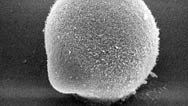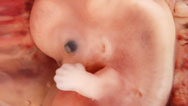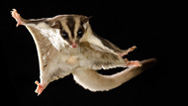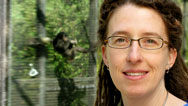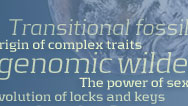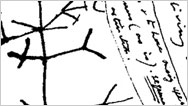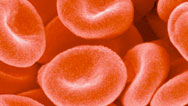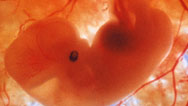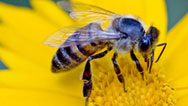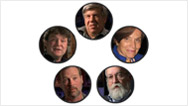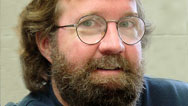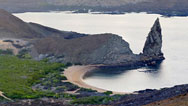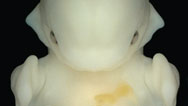
What Darwin Never Knew
One hundred and fifty years later, scientists decode nature's greatest mysteries—a two-hour special. Airing December 21, 2011 at 9 pm on PBS Aired December 21, 2011 on PBS
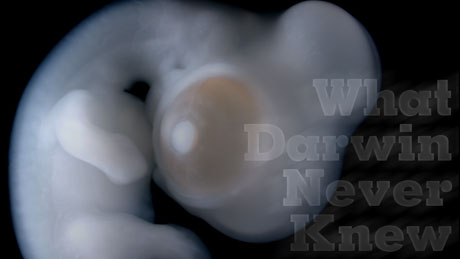
Program Description
Transcript
What Darwin Never Knew
PBS Air Date: December 29, 2009
NARRATOR: One question: "Why is there such a stunning diversity of life?"
One answer: "Evolution: Charles Darwin's brilliant theory that explains how species adapt and change." It's been called the best idea anyone ever had. But there's one big problem: How does it actually work?
Now, extraordinary science is answering that question. It is uncovering the hidden mechanisms inside creatures' bodies that can explain astonishing transformations like how birds can evolve from dinosaurs; why a fish was once your ancestor; and above all, what makes us human.
Right now on NOVA, you'll find out, What Darwin Never Knew.
The tree of life on Earth, is one of stunning diversity: 9,000 species of birds, 350,000 kinds of beetles, 28,000 types of fish; 2,000,000 living species and counting. And we are just one of them.
But why is there such an amazing variety of animals? Why are there so many types of fish, so many different species of beetle? How did this extraordinary profusion of life on Earth come about?
Today we celebrate the man who would ultimately answer that question: Charles Darwin.
He was born 200 years ago, and it is 150 years since he published the work that has become the bedrock of our understanding of life on Earth.
CLIFF TABIN (Harvard Medical School): What Darwin wanted to understand was how you get this extraordinary diversity of life on Earth. He was spot on. He really nailed it.
NARRATOR: Darwin's theory of evolution, his account of why species adapt and change, has been called the best idea anyone ever had.
But even Darwin admitted that his work was incomplete. Vast questions were still unanswered. And the biggest question was, "How?" How did evolution take place?
SEAN B. CARROLL (University of Wisconsin–Madison/Howard Hughes Medical Institute): He didn't know any of the mechanics of that process. He didn't understand the physical forces that would actually change the way species appeared.
NARRATOR: But today we can answer the questions that Darwin could not. We can look under the hood of evolution, and see exactly how this mysterious process gives rise to such astounding diversity.
CLIFF TABIN: What's incredible about this timing, from a scientific perspective, is we're going to be able to understand that diversity. And that just adds to the excitement. It doesn't demystify it, it makes it all the more magical.
NARRATOR: And this is the magic and mystery of evolution: over eons of time a single species gives rise to many. An ancient fish evolves to become the ancestor of all four-limbed animals, even us. And one species, our own, develops a large and uniquely complex brain, enabling us to dominate the planet.
This is the search for the answers to what Darwin never knew.
Darwin began his love affair with nature when he was a child, just like many of his modern followers, including evolutionary biologist Sean Carroll.
SEAN CARROLL: I developed my interest in animals the same way I think most biologists did, which was either going out in the backyard or going to zoos.
And anytime I got a chance, I'd flip over logs and look for salamanders and snakes and frogs and things like this. And I was just fascinated with their patterns and behaviors.
NARRATOR: So it was with the young Charles Darwin.
Young Charles liked to traipse around outdoors. He loved to collect beetles and things. He was a completely ordinary kid. And he didn't like school.
In fact he was such a poor student that his father, a rather successful physician and a pretty imposing figure, was worried about Darwin's direction in life.
So his father packed him off to Edinburgh, the finest medical school in Europe, to become a doctor. But young Charles was just too squeamish.
SEAN CARROLL: He was really horrified by medical school. He witnesses an operation on a child—and this was in the era before anaesthetics—and he fled the operating theater, vowing never to return.
NARRATOR: Next his father sent him to Cambridge to study for the clergy. He didn't succeed at that either, but he did find his direction in life, reviving his childhood interest in nature.
SEAN CARROLL: Darwin starts on his path to his divinity degree, and he starts to mature as a student. He becomes more serious about some subjects, particularly natural history; and he learns a lot more about botany, and about geology and these things. He's becoming a pretty solid field scientist.
NARRATOR: His reputation as a naturalist gained him a spectacular invitation.
SEAN CARROLL: Charles was offered a place on the British Navy ship, The H.M.S. Beagle, whose mission was to survey the waters around South America. Now the captain of the Beagle wanted a well-educated scientific person aboard, and a dinner companion, somebody to share conversation with. And Darwin fit the bill perfectly.
NARRATOR: And so, Charles Darwin set off on a fateful voyage that would revolutionize our understanding of life's great diversity.
The voyage of the Beagle took nearly five years. It wove its way from the Cape Verde Islands and along the coast of Brazil. It was in Argentina that he made his first important discovery.
SEAN CARROLL: Early on in the voyage he found some amazing fossils. He dug up some skulls, some jaws, some backbones of what turned out to be giant mammals. Now, these were clearly extinct, and Darwin began to ponder. What was the relationship of those fossils to the living mammals of South America?
NARRATOR: But one port of call on Darwin's voyage proved more important than all the others: the Galapagos. This cluster of 13 isolated islands lies 600 miles off the coast of Ecuador, in the Pacific Ocean.
These islands are home to unusual animals found nowhere else on Earth: penguins that live at the equator and swim in warm water, instead of the frigid seas of the South Pole; giant tortoises that weigh up to 600 pounds; iguanas, huge lizards that swim and dive in the sea—everywhere else, they dwell only on land.
Traveling for the first time in the Galapagos, Sean Carroll is seeing the same creatures that so intrigued Darwin.
SEAN CARROLL: Of all the animals, I think these marine iguanas are the greatest symbol of the Galapagos, what I most wanted to see here. And to see them in their native habitat, blending against that black rock, just as Darwin described it, is an absolute thrill. CHARLES DARWIN (Evolutionary Theorist, Passage taken from Darwin's diary) It is a hideous-looking creature, of a dirty black color, stupid and sluggish in its movements. They are as black as the porous rocks over which they crawl.
NARRATOR: Darwin meticulously described the iguanas in his diary, but he was far from the scientific authority he would become.
SEAN CARROLL: The Darwin that arrived here was not the great theorist that we know today. He was a 26-year-old collector, collecting, really, almost at random, any kind of plants, any kind of animals, any kinds of rocks. He didn't even know the meaning of what he was collecting, until much later.
He was also fascinated by the giant tortoises, which allowed him to ride on their backs as they slowly lumbered around. CHARLES DARWIN (Passage taken from Darwin's diary) I frequently got on their backs, and then, upon giving a few raps on the hinder part of the shell, they would rise up and walk away. But I found it very difficult to keep my balance.
NARRATOR: Darwin measured the creatures' extreme slowness: about four miles a day, he calculated. But the local people knew something else about the tortoises.
SEAN CARROLL: They could tell which island any tortoise came from just by looking at its shell.
NARRATOR: Their shells differed depending on which island they lived on. Some tortoises had shells shaped like a dome; others had shells arcing over their heads like a saddle; others differed subtly in color or by how much the bottom of the shell flared out.
Darwin had literally been sitting on a clue, a way to understand the great diversity of life. But he didn't yet realize it.
Instead Darwin turned his attention to birds. The islands were full of what seemed to be a familiar assortment of species. So he stuffed his collecting bag with what he thought were types of finches, grosbeaks, wrens and blackbirds.
And then, after five weeks in the Galapagos, Darwin and the Beagle went to other ports in the Pacific, and finally set sail for home.
On board he started to sort through the vast number of specimens he had collected on the five year voyage. But it was not until he returned to Britain that he was able to make sense of them.
It began with a startling revelation. All the different birds he had collected actually were variations of a single type.
SEAN CARROLL: He learns that those birds he had collected on the Galapagos actually represented 13 different species of finch.
NARRATOR: What misled Darwin was that they looked radically different: some had wide tough beaks, others had long slender ones. And these differences depended on which islands they lived on.
SEAN CARROLL: Now why would that be? Why would there be slightly different birds, slightly different species, on different islands, all in one part of the world?
NARRATOR: Darwin now thought back to the Galapagos tortoises. They too differed from island to island. His brain began racing.
SEAN CARROLL: Thoughts are starting to crystallize, take shape in his mind, bit by bit by bit. He starts this process he describes as "mental rioting," just a stream of consciousness where he's jotting down—note after note after note—thoughts as they occur to him.
And finally they converge on this one idea.
NARRATOR: What Darwin now realized was that somehow, for some reason, species change.
Originally, there must have been just one type of finch on the Galapagos, but over time it had diversified into many kinds, with different beak shapes; the same for the tortoises. One type of tortoise must have turned into many kinds, with different shells depending on which island they lived on.
With this great insight, Darwin entered dangerous new territory. The standard view at the time was that God had created every species, and that what God had created was perfect and could not change.
SEAN CARROLL: But Darwin said "No. Why would the Creator bother with making slightly different finches for each of these different islands that all looked alike?"
NARRATOR: The prevailing view just didn't make sense. But this was only the beginning of Darwin's revolution. He turned his attention to the fossils he had collected in South America. One was of a giant sloth, another was of a huge armadillo-like creature.
These animals were extinct, but little sloths still existed in South America, and so did smaller armadillos. What could this mean?
SEAN CARROLL: It dawned on him that they resembled each other, so what he had found in the ground were the buried ancestors of the living animals of South America. So, again, here was more evidence that species changed. Somehow these ancient giants must have been transformed into the smaller creatures we see today.
NARRATOR: But what Darwin would later find out, took this idea of how species change into a completely new league.
In Victorian times, scientists routinely studied life forms at the embryonic stage. How these tiny forms develop from just a single cell into an entire creature has long been seen as one of the wonders of nature.
MICHAEL LEVINE (University of California, Berkeley): Watching a developing embryo is truly the most glorious miracle of nature, no baloney.
NARRATOR: What Darwin learned from studying the embryos amazed him.
In snake embryos you could see tiny bumps, the bony rudiments of legs. But these would never develop in the adult snake. Darwin wondered: "Were snakes somehow descended from animals with legs?"
He learned that whales, which have no teeth as adults, had them as embryos.
Those teeth disappeared before they were born. To Darwin it had to mean whales were descended from creatures with teeth.
But human embryos provided the most startling evidence. Under the microscope, tiny slits around the neck were clearly visible: exactly the same structures were found in fish. But in fish they turned into gills; in humans, they became the bones of our inner ear. Surely this showed that humans must be descended from fish.
It's an astonishing thought.
OLIVIA JUDSON (Imperial College London): I don't know about your ancestors, but mine, you know, included, included priests and, you know, the, the usual, the usual suspects. But, but the idea that all of us have, have fish in our family tree, I think it's amazing.
NARRATOR: And so Darwin arrived at an astonishing conclusion, one that would become central to his understanding of the great diversity of life.
SEAN CARROLL: Darwin had this amazingly bold idea: the tree of life—that all species were connected. And what it meant was, if you go far enough back in our family tree of humans, you'll come to fish. If you go far enough back in the family tree of birds, you'll come to dinosaurs. So that creatures that don't look anything at all like each other are actually deeply connected. No one came close to having this idea before Darwin.
NARRATOR: This seemed to be an explanation for the vast diversity of animals. Beginning with a common ancestor, over time, across generations, species could change dramatically. Some might add new body features, others might drop them.
Ultimately one type of creature could be transformed into something utterly different. It's a process Darwin called "descent with modification."
But it all begged a question: why? What was making creatures change? Darwin needed clues. And he found them in a very surprising place.
Dogs: big, small, fat, tall. The British have long been obsessed by them.
It was a full-blown love affair in Victorian England. Even Her Majesty was dog-crazy.
That love affair still continues today, especially among scientists like Heidi Parker at the National Institutes of Health.
HEIDI PARKER (National Human Genome Research Institute): One of the most interesting things about working with the domestic dog is the kind of variation that you have. We have sizes that range from something the size of a groundhog, up to dogs like Zeppie, here, who can get to be the size of mule deer.
If we had that kind of size variation in humans, we would have people running around the size of Barbie⢠dolls.
NARRATOR: In his day, Darwin knew this range of sizes hadn't come about by chance. Through a careful process of selection, dog breeders mixed different dogs with different physical traits to create new forms.
HEIDI PARKER: Darwin was intrigued by what he was seeing breeders could do with domestic dogs. They could select for individual traits, such as size or shape, and they could actually change the look of their breed.
NARRATOR: The Whippet, for example, had been developed to chase rabbits. It was created by mixing greyhounds for speed, with terriers, used to hunt small game.
And then it hit Darwin. Was there a similar form of selection going on in nature, but without human interference? Could natural selection explain the great diversity of life?
SEAN CARROLL: It was brilliant. He took something very familiar and comfortable, for example, animal breeding, and explained that the same sort of thing was going on in nature, just at a little bit different pace and with no human guide.
NARRATOR: But what could be carrying out selection in the wild? It was then that Darwin took a completely fresh look at nature.
The Victorian view of nature was sentimental—lambs lay down with lions—but Darwin's travels on the Beagle led him to a different view.
For Darwin, nature was savage. Every creature was locked in a desperate struggle for survival, ultimately ending in death.
OLIVIA JUDSON: The scale of death in nature is absolutely horrendous. And sometimes it's not just there's a lot of death, but it's very unpleasant death.
NARRATOR: But, in all this brutal chaos, Darwin saw a pattern.
SEAN CARROLL: Darwin showed that nature was a battlefield and that everything was in competition. And this brutal battle, this war of nature as Darwin described it, was actually a creative process.
NARRATOR: The pattern that Darwin saw was that the creatures that survived were those best adapted to the specific environments they lived in. For instance, some could handle extremes of climate. Others were brilliantly honed killing machines, perfect for catching the available prey. Still others were perfect to evade those who might be hunting them.
But how did this harsh view of nature explain the finches on the Galapagos, where Darwin observed that that the birds on different islands had different beak shapes? Somehow those different beaks must be helping the finches survive.
CLIFF TABIN: The finches of the Galapagos Islands have beaks of many sizes and shapes. And there's a reason for that; they use their beaks as tools. Now, if you think of the type of tool you would want to crush a seed that's very tough, but is the food that you really like, you'd want a beak like this, which is the type of beak the ground finch has.
NARRATOR: On an island where the only food is seeds that are hard to crack, a short, powerful beak will mean a finch will survive. But on another island, the available food isn't seeds but flowers.
CLIFF TABIN: On the other hand, if you wanted to get into narrow spaces to get pollen and nectar, that are very hard to get at, you wouldn't need a big, strong beak, you'd need a probing beak.
NARRATOR: So on a different island, where you have a different food source, you have a different beak shape. And this pattern was repeated across the Galapagos.
It seems that the finches' beaks had altered to fit the diet of each particular island. And that was how one original type of finch had been transformed into many. But how had these changes come about?
Here Darwin had another clue. He could see it in his own family. As every parent knows, no two children are ever exactly the same. Charles looked different from his brother Erasmus, even though they shared the same parents.
Charles's children looked a bit like him and his wife Emma, but they, too, looked different from each other. That was something he called "variation."
SEAN CARROLL: He realized that not every individual was the same, stamped out like a toy from a press, but there was variation.
NARRATOR: Darwin realized that variation must be the starting point for change in nature. In any generation, the animals in a litter are never quite the same. And in the wild, such a tiny variation might make all the difference between life and death.
Two penguins, for instance, might differ a tiny bit in the thickness of their blubber, a big factor if you live in extreme cold. In a harsh climate, the environment will select who will live and who will die. And slowly, Darwin suggested, over many, many generations, these tiny variations would allow the fit to get fitter, and the unfit would vanish.
These variations accumulate and eventually new species branch off. This is evolution by natural selection. It is one of the keys to how new species are formed.
And so, in 1859, after years of painstaking research, Darwin finally published his masterwork, On the Origin of Species. It is still impossible to overstate its importance.
CLIFF TABIN: It was really a quantum advance in understanding. It shook people up, it changed the way people thought.
NARRATOR: Gone was the idea that all species were created perfect and immutable, taken as an article of faith. In its place, Darwin provided proper scientific theory, based on facts and observation.
OLIVIA JUDSON: It is much more than the presentation of simply the idea of natural selection. It's a vision of how evolution by natural selection works.
NARRATOR: One-hundred-fifty years later, his theory has stood the test of time.
SEAN CARROLL: What's amazing is that Darwin got so much right. His ideas largely stay intact today.
NARRATOR: But Darwin himself acknowledged that there were holes in his theory. He didn't actually know how it worked. What was happening inside a creature's body that makes it change?
But now, at last, modern science is providing the answers, through a hidden mechanism that Darwin knew nothing about.
Arizona's Pinacate Desert is a harsh and brutal place, especially if you're a rock pocket mouse.
MICHAEL NACHMAN (University of Arizona): They're the SNICKERS® bar of the desert. They really are. They're probably eaten by foxes and coyotes and rattlesnakes and owls.
NARRATOR: Weighing just half an ounce, this mouse could never fight off these large predators. Its best hope for survival is camouflage. Not surprisingly, its fur matches the color of the Pinacate rocks.
But in some sections of the desert, the environment is different. Ancient volcanoes erupted, and now the desert is a patchwork of dark lava and light rock.
But of course a light mouse on dark rock is easy pickings. So something has happened that Darwin might have predicted. The mice now living on the dark rocks have evolved darker fur. Those that stayed on the light rocks remain light.
Nachmann was fascinated. How had this happened? To find out he first needed to catch some mice. So, with Sean Carroll, he visits a line of traps he set the previous night.
MICHAEL NACHMAN: All of the dark ones have a white underbelly, and, presumably, there is no selection for a dark underbelly, because predators are coming from above.
NARRATOR: This much Darwin could have done: find some mice and compare the color of their fur to their environment. But Nachmann can now do something that Darwin never could; he can look inside the animals' D.N.A.
The study of D.N.A. is one of the great triumphs of modern science.
It has taken our understanding of how creatures evolve and develop to a level that Darwin could never have dreamed of.
SEAN CARROLL: The D.N.A. molecule is one of the real secrets of life. It's a perfect system for storing the vast amounts of information that's necessary for building all kinds of creatures.
NARRATOR: D.N.A. consists of one long molecule, spiralling around in a double helix. That helix is, in turn, made up of four smaller molecules, called by the letters G, A, T and C.
D.N.A. can be found in the cells of every living thing on Earth.
OLIVIA JUDSON: The thing about D.N.A. that I think is remarkable is that the molecule itself is so elegant: with a small number of letters, you can say almost infinite words.
NARRATOR: And that is the key. D.N.A. is a code, and its double strand contains all the information to make living things grow and develop. Lined along each D.N.A. molecule arranged special sequences of this code that form our genes.
Many genes get translated into proteins, and these proteins make the stuff of our bodies. One protein makes hair; another makes cartilage; others make muscle.
SEAN CARROLL: What makes D.N.A. so amazing is that contains just four letters but all sorts of combinations of those four letters contains all the information for making all the creatures that are on the planet.
NARRATOR: It's a gene that determines whether our eyes are blue or not. Another gives us freckles. Another gives us dimples. But D.N.A. has one other vital quality: it doesn't stay the same.
When a baby is conceived, the fertilized egg receives half its D.N.A. from the mother and half from the father, creating wholly new combinations. It's why we look a bit like our parents, but also different.
Another way that D.N.A. can change is mutation.
SEAN CARROLL: Mutation is a critical ingredient in the recipe for evolution. Without mutation, everything would stay constant, generation after generation. Mutation generates variation, differences between individuals.
NARRATOR: Mutations can happen as our D.N.A. copies itself when our cells divide and our bodies develop. An A, for instance, can be replaced by a G or a C by a T. This can cause minute changes that no one is even aware of.
But when mutations occur in the cells we pass down to our children, they can cause big changes, like turning a light-colored mouse dark.
SEAN CARROLL: Mutation seems to mean that something bad has happened. Well, mutations are neither good or bad. Whether they are favored, or whether they are rejected, or whether they're just neutral, depends upon the conditions an organism finds itself in. So, for the pocket mouse, a mutation that caused the mouse to turn black, that is good if they're, you're living on black rock. It's bad if you're living out in the sandy desert.
NARRATOR: It was that mutation, the one that turned a light-colored mouse dark, that Michael Nachmann was hunting for.
Back in the lab he began the painstaking business of comparing the genes of the two types of mice, trying to pinpoint any differences.
MICHAEL NACHMAN: Science is fun when you really don't know what you're going to find.
NARRATOR: One by one, the genes in the two mice proved identical. But then, in one gene, he found something. There were four places where the sequence of As, Ts, Cs and Gs were different.
When a mouse is born with these mutations, its fur grows dark. And that means it can survive on the dark rocks when others would not. Here was a clear example of evolution and natural selection at work.
MICHAEL NACHMAN: I think Darwin would have been delighted to know that we can find the genes that are responsible for evolutionary change.
NARRATOR: And this was just one of many links that have been found between genetic mutations and evolution.
Scientists can now pinpoint a range of examples of evolution in action. The Colobus monkey can see in color because of a mutation in one gene; it can now tell nutritious red leaves from tough old green ones. A genetic glitch gave this Antarctic fish a potent antifreeze in its blood, so it can survive in the icy waters when others cannot.
So powerful was this link between genetic mutation and evolution that an idea took hold: to understand how evolution works, all you need to do is compare creatures' genes.
SEAN CARROLL: One might think that you could understand all of evolution, simply by mapping the genes of every creature. Identify all the genes, identify all the differences, and you could explain the differences between, say, a mouse, and monkeys and humans.
NARRATOR: So, when the human genome project began, in 1990, the scientific world was on tenterhooks. All three billion letters of our D.N.A. were going to be identified, in order.
In parallel, the D.N.A. of some animals and plants was also being sequenced. Surely this would be a quantum leap in our understanding of how different life forms evolved?
With this came another idea: that complex animals like us would have many more genes than simpler ones.
SEAN CARROLL: Here we are, the most complex and sophisticated animal on the planet, right? You might think that would require a whole lot more genetic information.
NARRATOR: The betting was on. Just how big would our genome be compared to other life forms?
OLIVIA JUDSON: There were estimates that humans would have between, let's say, 80,000 and 120,000 genes.
NARRATOR: So when the final answer came in 2003, it was a shocker: 23,000 genes, the same number as a chicken, less than an ear of corn.
MICHAEL LEVINE: People were freaked out by the relatively small number of genes. It's down to something like 22- or 23,000 protein-coding genes in a human genome.
The simple nematode worm has about that same number. And there are plants that have considerably more genes than the glorious human genome.
OLIVIA JUDSON: The whole human genome project has been a humbling experience, as we've discovered, that, actually, it doesn't take as many genes to make a human as we had all hoped.
NARRATOR: And it wasn't just that we had so few genes, but many of our key genes were identical to those of other animals.
Huge though the breakthrough had been, the genetic revolution had opened up a whole new set of puzzles. As a solution to the mystery of how evolution works, genes and their mutations were only part of the story. There had to be something else, more subtle and more mysterious going on.
SEAN CARROLL: We have to explain, then, "How do you get all these differences, if you have really similar sets of genes?"
NARRATOR: The quest to uncover what Darwin never knew would have to start again.
The first tantalizing clues would come from those life forms that Darwin himself had studied, embryos.
Look at these embryos. It is almost impossible to tell, just days after conception, which is the chicken, the turtle, the bat, the human. They look almost the same.
Only as they grow, does it become clear which is which. Darwin wondered, as scientists do today: how could they start out so similar and end up so different?
MICHAEL LEVINE: There is something profound about what the embryo was telling us. And we have rediscovered what Darwin was talking about all along, that the embryo is where the action is, in terms of animal diversity. It is the platform for diversity.
NARRATOR: What fascinates modern biologists is that all these different animals don't just look the same, they are using virtually the same set of key genes to build their bodies.
The body-plan genes determine where the head goes; where the limbs go, and what form they take: whether they are arms, legs or wings.
Another set of genes determines an animals body patterning: the blotches, the stripes and spots.
It is the same genes at work in every creature from the leopard to the peacock to the fruit fly, and yet they produce radically different results.
This has led scientists to a crucial insight about how animal bodies have evolved. It's not the number of genes that counts.
SEAN CARROLL: It's not the genes you have but how you use them that creates diversity in the animal kingdom.
NARRATOR: Finding out just how these same genes are used to create such amazing diversity has been the work of Sean Carroll and an unlikely hero of modern science: the fruit fly.
SEAN CARROLL: As much as I'd like to study the mammals of the African savannah, they make poor choices for laboratory animals. They're large, expensive and then reproduce very slowly. To get data, we have to find the simplest examples of the phenomenon we want to understand.
NARRATOR: But the humble fruit fly does weird and wonderful things.
This fruit fly is dancing for sex. A rapt female takes in the show. She's particularly besotted by the dark spots on the male's wings.
Watching it all is an equally besotted Sean Carroll.
SEAN CARROLL: You might think them to be just annoying, but they're really charming. The males of this species does a rather elaborate courtship dance where he displays these spotted wings in front of the female. To us, it's as magnificent as what a peacock does.
NARRATOR: But in some species of fruit fly, the males don't have wing spots.
SEAN CARROLL: There is another fruit fly species that is different from the spotted species in two important ways: it doesn't have spots on its wings, and it does a lot less dancing.
NARRATOR: Here then is a classic evolutionary puzzle. Why does one type of fly have spots and the other doesn't? Sean Carroll wanted to know what is going on in their genes that makes them different.
SEAN CARROLL: So we wanted to take apart the genetic machinery for making wing spots, to understand how those wing spots evolved.
NARRATOR: Carroll began the process of sifting through the two types of flies' D.N.A. He had one clue to set him on his way. He already knew the gene that codes for the black wing spots. He calls it the paintbrush gene.
But surprisingly, when he compared the genes of the two flies, they both had that gene, and yet only one had spots.
SEAN CARROLL: When we look at that gene in the two species, really, they both have this paintbrush gene. So the big difference is not having the gene, it's how they use it. One species is using it to make spots, the other one doesn't.
NARRATOR: So why did the paintbrush gene create spots in one type of fly but not the other?
In search of answers, Carroll turned to one of the least understood regions of D.N.A. The vast stretches that were once known as junk.
It has been called the dark matter of the genome: mysterious, uncharted, strange.
The vast bulk of the double helix, some 98 percent of it, doesn't code for proteins, which make the stuff of our bodies. The genes which do comprise just two percent.
Even now, no one is sure what much of this huge non-coding area actually does, but it has long beckoned evolutionary detectives, like Sean Carroll.
So that is the fragmented test?
Carroll had already learned that the paintbrush gene itself was identical in the two types of fly. So he extended his search through their D.N.A. And in one place, just outside the paintbrush gene, he found an important clue: a stretch of D.N.A. that was different in the fly with wing spots.
What could this mean?
So Carroll conducted an experiment. He decided to put that mysterious stretch of D.N.A. that he had found in the spotted fly in the unspotted fly. To help him see if it had any effect, he attached it to a gene from a jellyfish, a gene that codes for a protein that makes the jellyfish glow.
SEAN CARROLL: We cut the D.N.A. up into little pieces, and we hook it up to a protein that glows in the dark. And then we inject that into the unspotted fly.
NARRATOR: And then something remarkable happened.
SEAN CARROLL: When we looked at those unspotted flies, we see, now, their wings are glowing in the dark with spots.
NARRATOR: Somehow that mysterious stretch of D.N.A. had turned on the paintbrush gene in the unspotted fly's wings. Once spotless, now it had luminous spots.
SEAN CARROLL: Bingo. We had found the piece of D.N.A. that mattered.
NARRATOR: Carroll had found something that is revolutionizing our understanding of how different animal bodies have evolved.
A piece of D.N.A. called a switch. Switches are not genes. They don't make stuff like hair, cartilage or muscle, but they turn on and off the genes that do.
SEAN CARROLL: Switches are very powerful parts of D.N.A., because they allow animals to use genes in one place and not another; at one time, and not another; and so, choreograph the spots and stripes and blotches of animal bodies.
NARRATOR: In the case of the fruit fly it is a mutation, a change in just a few letters of the D.N.A., that has caused the paintbrush gene to be switched on. And so, a whole new species with wing spots has been created.
But switches are now explaining far more than that. They are helping to solve many perplexing evolutionary questions, like how one creature can become another creature by losing it legs.
It all goes back to what Darwin had seen in the snake embryo: the rudiments of leg bumps. This convinced him that a snake must have evolved from some four-legged animal.
Over the years that same mysterious process, the losing of legs, has been seen in other creatures, like the whale. Its front flippers have all the bones of a land creature's arm, even the fingers. And further back in its body, it has the vestiges of a pelvis. Clearly it is descended from an animal that walked on the land.
DAVID KINGSLEY (Stanford University, Howard Hughes Medical Institute): Lots of animals have evolved to slither through the ground, like snakes. Other animals slither or swim through the water, like, like whales. So if you need a streamlined body, it's good to get rid of these things that stick out from the body, like limbs.
NARRATOR: Like the whale, the manatee is another huge mammal that lives in the sea. And it, too has lost its hind legs. How?
Darwin could never have answered that question, but now, thanks to our understanding of how D.N.A. is switched on and off, and a very small fish, we are getting a little closer.
In this lake, in British Columbia, there is a creature that really shouldn't be here: a stickleback.
Most sticklebacks live in the ocean, but some 10,000 years ago, a few were left stranded in this lake, cut off from the Pacific. And over the years, they have evolved.
The ocean stickleback has a pair of fins on its belly that are like spikes. They are for defense. The spikes make the stickleback hard to eat.
But the lake sticklebacks have lost those spikes on their bellies. And it is this that intrigues researchers David Kingsley and his colleague Dolph Schluter.
To understand what's behind it, they first identified the gene that makes the stickleback's spikes. It's one of those key body-plan genes and, not surprisingly, they found it to be identical in both the ocean and the lake stickleback.
The question was, "Why hadn't it been turned on in the lake stickleback, which had lost its spikes?"
Kingsley felt the answer might lie in a switch.
DAVID KINGSLEY: We know these genetic switches exist. But they're still very hard to find. We don't have a genetic code that lets us read along the D.N.A. sequence and say, "There's a switch," to turn a gene on in a particular place.
NARRATOR: But eventually, hunting through the vast stretch of D.N.A. that does not code for proteins, he found it, a section of D.N.A. that had mutated in the lake stickleback. These mutations meant that the switch was broken. It didn't turn on the gene that makes spikes.
But this work may have implications far beyond sticklebacks. They are convinced that there is a link between the stickleback losing its spikes and other creatures, like a manatee, losing their legs. And they have two tantalizing clues.
One: the same body-plan gene that is responsible for the stickleback spikes also plays a role in the development of the hind limbs.
The second clue is more tentative. The lake stickleback may have lost its spikes, but evolution has left behind some tiny remnants: the traces of bones. And they are lopsided, bigger on the left than on the right.
DAVID KINGSLEY: We thought, "Wouldn't it be amazing if, in fact, this classic unevenness is the signature of using the same gene to control hind-limb-loss in incredibly different animal?"
NARRATOR: So Kingsley and his team went looking in manatees, searching for this lopsided pattern. And they found it. In box after box of manatee skeletons they saw pelvic bones that were bigger on the left and smaller on the right.
Right now, Kingsley and his team are looking for the same switch in the manatee that caused the lake stickleback to lose its spikes. And if they find it, they will have a powerful explanation for something that baffled Darwin: how creatures like manatees, whales and snakes can evolve away their legs.
But all this begs another question. If switches can play such a profound role in the different shapes and patterns of animal bodies, from wing spots, to spikes, to hind legs, what is throwing those switches in the first place?
Researchers would see the answer in animals very familiar to Darwin: those Galapagos finches.
Arkat Abzhanov and Cliff Tabin have spent years trying to find out exactly how those Galapagos finches got their different beaks. Their starting point was what they had learned from Darwin himself: their beaks were vital to the birds' survival.
On an island where the main food was seeds, finches had short, tough beaks for cracking them open. On an island where the main food was from flowers, birds had long pointy beaks for sucking up nectar and pollen.
And they knew something else: the finches are born with their beaks fully formed. So the answer to why they had such different beaks must lie in something that happened to the finches as embryos, in the egg.
CLIFF TABIN: Something amazing is happening inside those eggs. Genes are turning on and off. And depending exactly on how they turn on or off will determine what type of finch is formed.
NARRATOR: To find out just what was going on, the researchers first had to collect some eggs.
ARKHAT ABZHANOV (Harvard Medical School): There she is...just got back and about to lay some eggs. Quite likely that she already has a batch. She's coming out.
NARRATOR: Abzhanov checks a ground finch nest and finds a single egg. He won't remove it because the mother might abandon the nest. Another nest already has three eggs. He takes one for his research, as he knows the mother will lay a replacement.
The team collects several eggs, with embryos at different stages of development. That way they will be able to chart exactly how the different beaks grow.
Back in the lab, they can begin the process.
This cactus finch embryo is well on the way to its signature long, pointy beak. And this ground finch embryo is growing a short thick beak.
CLIFF TABIN: What we wanted to do was try and understand the genes that were involved in making the beak the way it was, making a big, broad thick beak different from a long, thin beak or a short, thin beak.
NARRATOR: They concentrated on a group of genes known to control the growth of birds' faces. As they looked, they saw something intriguing.
One particular body-plan gene became active in the ground finch—with the short, thick beak—on the fifth day of development, but it didn't go to work in the cactus finch—with its long, slender beak—for another 24 hours.
This was a revelation. The same genes were responsible for the beaks in all types of finch. Any differences were in timing and intensity.
CLIFF TABIN: We've got it; we've nailed it. It's the same genes in making a sharp, pointy beak or a broad, nut-cracking beak. What is essential and makes the difference, and all the difference, is how much you turn the gene on and when you turn it on, when you turn it off.
NARRATOR: And the revelations didn't end there. There was something special about this gene. Like all body-plan genes, it doesn't actually make the stuff of our bodies. It didn't make the cartilage for the finches' beaks. It throws switches, and the switches then turn on or off the genes that do make the beak.
SEAN CARROLL: These are a different type of gene; they're the genes that boss other genes around.
NARRATOR: Scientists now realize that not all genes are created equal. Some make the stuff of our bodies, and switches are needed to turn many of these stuff genes on and off. The body-plan genes are what throw these switches, which tell the stuff genes what to do and when.
This subtle choreography can have profound effects on how different animal bodies are formed.
And this knowledge is helping us solve perhaps the biggest Darwinian puzzle of all: the mystery of the great transformations.
It all goes back to Darwin's idea of the tree of life, that all life-forms are ultimately related, and from the earliest common ancestor, over billions of years, they have changed and diversified, so that creatures that started out looking the same, evolved to become completely different.
And scientists have made some amazing connections: that dinosaurs share a common ancestor with birds; and that a fish must have been the ancestor of all four-limbed creatures, even us.
Of all his ideas this was probably Darwin's most astonishing.
SEAN CARROLL: It was one thing to grasp how two species of finch could become different, how their beak shape could change. That was a small step. But what about the big differences, the differences, say, between the fish that swim in the sea and the animals that walk on land? How did those changes take place?
NARRATOR: Over the years evidence for these great transformations has been found. For instance, just a year after Darwin published On the Origin of Species, a fossil called archaeopteryx was discovered. It had features of both birds and dinosaurs.
And Darwin had seen equally persuasive evidence in embryos. Those slits in the ear of all land creatures, even humans...in us, they become tiny bones in the inner ear, but in fish, they become gills—a tantalizing hint that land animals must be descended from fish.
But the stumbling block has always been how? How could a fish develop legs and walk on land.
Darwin had no idea, but Neil Shubin was determined to tackle that problem.
NEIL SHUBIN (University of Chicago/The Field Museum): It captured my imagination. I mean, here's a fin, and on the other side was a limb, and they looked different in many ways. And I thought, "Well, what a first-class scientific problem to devote my research to!" And I've been devoting pretty much my research to it, ever since—over 20 years.
NARRATOR: The first stage in Shubin's quest was to find a fossil.
If Darwin were right, somewhere out there, there had to be a transitional form, a fossil that was part fish, but had the beginning of legs. But where to look?
He had one clue. The fossil record shows that creatures with legs first appeared some 365 million years ago. Before that, there were only fish.
So, summer after summer, Shubin set up camp on Ellesmere Island, just a few hundred miles from the North Pole. It has exposed rock from that crucial transitional time. The scientist's own video shows how remote and bleak the place was.
NEIL SHUBIN: It's cold; it's about freezing every day over the summer. Winds are high; they can get up to 50 miles per hour. There are polar bears there. We have to prepare ourselves by carrying guns. It's a beautiful place. You've got to love it. It's my summer home.
NARRATOR: Each expedition was costly, but, after three of them, there was little to show for their efforts. A fourth trip seemed pointless.
NEIL SHUBIN: I remember having a conversation with my colleagues saying: "Well, should we go? Is this really a waste of money?" This was our do-or-die moment, and we almost didn't go.
NARRATOR: But they decided to try one last time.
After three days they still hadn't found anything. Then, just when no one was expecting anything to happen...
NEIL SHUBIN: A colleague was cracking rocks, and I was working five feet away from him. And I hear "Hey! Hey, guys, what's this?" And sticking out of the cliff was the snout of a fish—and not just any fish, a fish with a flat head. And by seeing a flat-headed fish in rocks about 375 million years old, we knew that we had found what we were looking for.
NARRATOR: A flat snout, with upward staring eyes, the signature of an animal that pushes its head out of the water. And for that, it would have needed something like arms.
NEIL SHUBIN: What we did at that moment was all jump around high-fiving. It was a, you know, there were only six of us in the field that time, so it was quite a scene.
NARRATOR: Back at home, Shubin and his team got to work, examining their 375-million-year-old fossil.
They named their new finding Tiktaalik, an Inuit word for a freshwater fish.
Tiktaalik is a perfect transitional form. Much of its body is that of a fish. It's covered in scales. But it also had something very un-fishlike, an arm-like fin, or, perhaps, a fin-like arm. Tiktaalik had the bone structure that is seen in the arms and legs of every-four limbed animal: one big bone at the top; two bones underneath, leading to a cluster of bones in the wrist and ankle.
It's the same pattern that is found in everything from sheep, to sheepdogs, to Shubin himself.
NEIL SHUBIN: You now have an animal that can push itself up off the substrate, either on the water bottom or on land.
NARRATOR: One obvious question was, "Why had Tiktaalik evolved to this new structure?"
One possible answer is suggested by other fossils found near it.
NEIL SHUBIN: There are large predatory fish, about 10 to 15 feet long, living alongside Tiktaalik.
NARRATOR: Tiktaalik was prey. To survive it had few choices.
NEIL SHUBIN: You can get big, you can get armor, or you can get out of the way.
NARRATOR: Neil Shubin thinks Tiktaalik got out of the way. With those arm-like fins, it could have dragged itself to safety on land or in the shallows, but this was only half the answer.
NEIL SHUBIN: What it doesn't show us is the actual genetic mechanism, the genetic recipe that builds a fin into that which builds a limb.
NARRATOR: At 375-million years old, Tiktaalik's D.N.A. had vanished long ago.
Shubin needed a next of kin, a fish relative that was still alive.
NEIL SHUBIN: What we needed was a creature that was in the right part of the evolutionary tree, but also a fish that had a very fleshy fin. So the search was on.
NARRATOR: A number of fish fit the bill, but Shubin favored one in particular: the paddlefish.
NEIL SHUBIN: The paddlefish is a really weird fish. They have developed this really long snout, and they are really voracious. They eat each other. Oftentimes you will lose a lot of your fish when they swim together, because they will eat each other.
NARRATOR: Living in the shallow waters of the Mississippi, it's also a living fossil.
Scientists have spent years working out the relationships between different species of fish, and they know that the paddlefish is one of the last survivors of the class to which Tiktaalik once belonged.
But unlike Tiktaalik, the paddlefish is in plentiful supply.
NEIL SHUBIN: Paddlefish is a common source of caviar, so we get our paddlefish from caviar farms.
NARRATOR: Intriguingly, even though Tiktaalik is extinct, the paddlefish is actually the more primitive form. Its fins bear far less relation to an arm or leg than Tiktaalik's.
And because they are related, the two kinds of fish should share the same genes, so Shubin began looking at paddlefish embryos, hunting for the genes that built its fins. And soon he zeroed in on one particular group of body-plan genes called Hox genes.
Hox genes have been found in all complex animals, from the velvet worm that dates back some 600 million years, to the modern human. And in all that time, the letters of their D.N.A. have remained virtually unchanged.
They are aristocrats of the gene community, near the very top of the chain of command. They give orders that cascade through a developing embryo, activating entire networks of switches and genes that make the parts of the body. They are absolutely critical to the shape and form of a developing creature.
SEAN CARROLL: These genes determine where the front and the back of the animal's going to be; the top, the bottom; the left, the right; the inside, the outside; where the eyes are going to be; where the legs are going to be; where the gut's going to be; how many fingers they're going to have.
NARRATOR: Shubin found that Hox genes had a key role in the formation of paddlefish fins. One set of Hox genes orders the first stage of fin development, a sturdy piece of cartilage that grows out from the torso.
Amazingly, in all four limbed animals, even us, exactly the same genes create the long, upper arm bone.
In the paddlefish, another set of Hox genes command the next stage of fin development. Again, exactly the same genes control the growth of our two forearm bones.
Finally, the same genes, working in a different order, make the array of bones at the end of the fin. The same sequence of the same genes makes our fingers and toes.
This was a massive revelation. Suddenly the origin of creatures with arms and legs didn't seem such a huge leap after all. If the same genes were at work in Tiktaalik, then many of the genes needed to make legs and arms were already being carried around by prehistoric fish.
All it needed was a few mutations, a few changes to the timing and order of what was turned off and on, and a fin could become a limb.
NEIL SHUBIN: Oftentimes, the origin of whole new structures in evolution don't involve the origin of new genes or whole new genetic recipes. Old genes can be reconfigured to make marvellously wonderful new things.
NARRATOR: So it is now possible to answer what Darwin didn't know and explain how all four-legged creatures could be descended from fish.
Around 375-million years ago, a creature like Tiktaalik was under attack, harried by predators. But some random changes to the activity of the Hox genes led to its fins developing a structure like a limb.
Tiktaalik could now haul itself out of danger, onto dry land. On land, it would have found a world of plants and insects, a world ripe for colonization, a world perfect for animals with arms and legs.
And so, over millions of years, these new limbs evolved, changed and diversified. Some became adapted for running, others for flying;some for digging, others for swinging. And so, four-limbed creatures took over the world in a multitude of different ways, and all because of some changes to an ancient set of genes.
And this is the true wonder of where our new understanding of D.N.A. has led us to: there are genes that make the stuff of our bodies, switches that turn them off and on, and still other genes that give those switches orders. Together, in a complex cascade of timing and intensity, they combine to produce the amazing diversity of life on this planet. That truly is something that Darwin never knew.
But can this new science also explain perhaps the most fundamental question of all: "What makes us human?"
The scope of human activity is simply astounding.
KATIE POLLARD (University of California, San Francisco): What fascinated me were all the crazy things that humans do. You look around the world, and if there is something bizarre and interesting that you could be doing, humans are up to it somewhere in the world. And when you look at all of this, you have to ask yourself, what makes us so special. And what is the basis for this humanness?
NARRATOR: For all nature's wonders, the achievements of the human mind are truly unique. We are the only species to think about what others think about us; to punish those who have harmed others; to create art, music, architecture; to engage in science, medicine, the microchip.
Only we can destroy millions at the push of a button.
Hardly surprising, then, that for centuries, we thought that humans were different from all other species: better, created in the image of God.
But then Darwin began to draw conclusions, from evidence like gill slits in human embryos, that showed that we were descended from fish. But it was when he drew parallels with other close relatives that he got into real trouble.
SEAN CARROLL: Shortly after Darwin returned from his voyage, in London, an orangutan named Jenny went on exhibit. And this was a huge sensation. This was the first great ape to be exhibited in captivity. And Darwin was absolutely taken with how she was, sort of, childlike in her ways. And he saw a lot of human behavior in the way this orangutan behaved.
NARRATOR: When Darwin suggested that human beings must actually be descended from apes, he was savaged. He was accused of attacking that core belief that humankind had been created in the image of God, above all other creatures.
But today, the idea that we share a common ancestor with apes is completely accepted in biology. Instead, as a result of having sequenced the genomes of both humans and apes, we face a very different puzzle.
Katie Pollard is an expert on chimp D.N.A.
KATIE POLLARD: Given all the obvious differences between humans and chimps, you might expect our D.N.A. to be really different. But, in fact, it's more like 99 percent identical.
NARRATOR: Just a one percent difference in the D.N.A. of humans and chimps.
The mystery facing modern science is not, "How can such different animals be related?" But, "How can such closely related species be so different?" That really is something that Darwin never knew.
But slowly, scientists are starting to find the answers. And one answer begins with insights into the genetics of a key human organ, our hands.
The human hand is a marvel; nimble and dexterous, nothing quite like it exists anywhere else in nature. It offers us a unique combination of precision and power, and much of that is down to one particular digit, our thumb.
JIM NOONAN (Yale University): One of the features of the human hand is our ability to touch all four fingers with the thumb. And that allows us to make grips like this, grips that give us a lot of precision. The power grip is the ability to put a lot of strength into this sort of contact.
So if you're holding a ball, you're basically pinching it, and we can put a lot of strength into that.
NARRATOR: The better to throw a fastball with.
Finding out why we have such versatile hands, compared to our nearest relatives, is the task of Jim Noonan, at Yale University. He began sifting through that vital one percent of D.N.A. that is different in humans from chimps.
JIM NOONAN: It's, kind of...one of the fundamental questions in science is, "What makes us who we are?" And that's really what we're trying to get to—what makes humans human.
NARRATOR: It was slow work. One percent may not sound like much, but it's still some 30 million of D.N.A.'s chemical letters: As, Ts, Cs and Gs.
JIM NOONAN: The genome's a big place. And just by looking at a sequence, it, you really can't tell, for the most part, what is important and what isn't.
NARRATOR: But eventually, in human D.N.A., he spotted something: a sequence that was different in 13 places, compared to chimp D.N.A. The trouble was, he had no idea what this piece of D.N.A. actually did.
To find out, he inserted it into the embryo of a mouse. To make the effects of the D.N.A. easier to follow, he attached it to another gene that gives off a blue color. That way he could see where the gene became active in the embryo.
As the embryo developed, the piece of D.N.A. seemed to be active all over the place, but most intriguingly, it was doing something in the growing paw.
JIM NOONAN: I thought, "Wow, this is really cool!" It was, it was a really striking image.
NARRATOR: What Noonan saw was that the human D.N.A. became active in the mouse embryo's thumb and big toe. It seems that Noonan may have found a switch that helps form that key human attribute, our thumb, the part of our hand that gives us so much power and precision.
It's that power and precision that enables us to hold a paintbrush, manipulate tools, pilot a jet fighter, record our thoughts, all those things that separate us from other apes.
Of course having a nimble hand is one thing. But you have to know how to use it. And for that you need to have humankind's other signature organ, our brain.
The human brain is vast—three times bigger than a chimp's—and is structured very differently. How this extraordinary organ evolved is central to understanding why we are the way we are. It is something that Darwin himself was at a loss to explain, which is why many of his critics remained unconvinced by his account of human origins.
But now, part of the answer to why we have such a remarkable brain may have come from a surprising source.
Hansell Stedman is a dedicated athlete and a medical doctor. He never imagined he would come up with an answer to a profound evolutionary mystery. He has devoted his career to trying to cure muscular dystrophy, a distressing and sometimes fatal degenerative disease. His quest is very personal.
HANSELL STEDMAN (University of Pennsylvania School of Medicine): My first exposure to muscular dystrophy was inescapable. My younger and my older brother both were born with muscular dystrophy.
NARRATOR: Muscular dystrophy is a genetic disease. Its sufferers have a mutation in one gene that robs their muscles of the ability to repair themselves.
HANSELL STEDMAN: ...typical workout, here on the rocks, might blow through a few thousand muscle cells, but they'll regenerate overnight, and if anything, be a little stronger the next day I come in, as a result of all of that. Whereas, in muscular dystrophy, the injury process is greatly accelerated, and the injury process outstrips the body's ability to repair.
NARRATOR: In search of a cure, Stedman is investigating the hundreds of genes that control the development of muscles. So when the human genome project took off, Stedman seized his chance.
HANSELL STEDMAN: When the horsepower of the entire human genome project kicked in, we knew exactly what to look for.
NARRATOR: Stedman was hunting for any new muscle-making genes. And so, as the human genome was sequenced, he began sifting through the vast mountains of data.
Eventually he found what he was looking for: a previously unidentified muscle-making gene. But there was something strange about this new gene. It didn't look like any other muscle-making genes. Two letters were missing.
This gene should cause a disease.
HANSELL STEDMAN: It became very clear, early on, that if you have a mutation of this type, you get some serious muscle problem going on.
NARRATOR: Here was a puzzle. Why would humans carry a gene that was clearly damaged? Perhaps it was simply a mistake in the data.
Stedman decided to dig a little deeper and look in another human subject.
HANSELL STEDMAN: In the department of true confessions, we do certain experiments first on ourself, largely out of convenience. You can swab your own cheek and get working on some D.N.A.
NARRATOR: To his utter amazement, he found the same damaged gene in himself.
HANSELL STEDMAN: I'm seeing this in my own D.N.A., and it's suggesting that, "Wait a minute. That means there's a muscle disease here somewhere, a muscle disease that I'm unaware of." And I thought it would be worth checking this out in some other members at the lab.
NARRATOR: A few swabs later and...
HANSELL STEDMAN: Sure enough, at the end of the day, every single person had the same glitch in their same D.N.A. at the same place.
NARRATOR: Here then was a real mystery. It seemed that this peculiar muscle-making gene was common in humans. But when he identified the same gene in apes, it was just like any other muscle-making gene.
Why was there such a difference? What did this gene enable one species to do that the other could not?
Stedman began to research the role of this gene in apes. And he found it made one particular kind of muscle. The muscle for chewing. In fact, the muscle used to close the jaw. In humans, that genetic glitch meant that we chew with just a fraction of the force of an ape.
This in itself was interesting, but where Stedman went next was truly intriguing, and highly controversial.
He drew a direct connection between the power of our jaw muscle and the evolution of the human brain. Stedman's thinking goes like this: the skulls of apes and humans are made of several independent bone plates. They let our heads get bigger as we grow. The muscles for chewing pull against these plates, and in an ape, these forces can be enormous.
HANSELL STEDMAN: So in the gorilla, the muscle, the size of a human thigh muscle, lives here and has to go through this large space to power the jaw moving back and forth. We're not talking biceps, triceps here, we're talking quad here. This is an enormous muscle that has to come right through this hole here to power the jaw-closing apparatus.
NARRATOR: Stedman contends that all this muscle power forces an ape's skull plates to fuse together at an early stage, and this puts limits on how much the brain can grow.
HANSELL STEDMAN: In a chimpanzee, gorilla or orangutan, those growth plates are pretty much shut down, closed for business, by about three, four years of age. In a human, they remain open for growth to perhaps the age 30.
NARRATOR: This, Stedman believes, is the key. A mutation in our jaw muscle allows the human skull to keep expanding into adulthood, creating a bigger space for our brain. And so our most important organ is able to grow.
HANSELL STEDMAN: It's very cool, to us, to think that some kind of muscle-altering mutation might actually have been a signature event in the evolution of what makes us a distinct species. It might have been absolute prerequisite for landing us where we are today.
NARRATOR: But having the space for a big brain is one thing. What is needed to actually grow one?
That is the question that Chris Walsh is trying to answer. He's another scientist who never expected to be taking on what even Darwin didn't know.
CHRIS WALSH (Children's Hospital Boston): I never thought that I'd be studying evolution. I'm a neurologist, interested in the brain and kids with neurological problems. And no one was more surprised than us to find that the study of kids with disabilities would lead us into these fascinating evolutionary questions.
Is he breathing generally good, during the day?
MOTHER OF MICROCEPHALY PATIENT: Sometimes it will go fast: huh, huh.
NARRATOR: Chris Walsh is a specialist in a rare disorder called microcephaly. Children with microcephaly are born with brains that can be a half the normal size.
CHRIS WALSH: This disorder can be very devastating for the kids that have it. They typically will have severe mental retardation, and so, will not be able to achieve normal language and normal schooling. And so it's really an event that defines the whole family. It defines the lives not only of the child but of the parents of that child. And these families are desperately eager to try to understand, at least, what caused the disorder in their kids.
NARRATOR: The purpose of Walsh's work was, initially, to help families that might be carrying any defective genes causing microcephaly to plan their lives.
CHRIS WALSH: We're able to offer those families predictive testing, so that if they're planning on having additional children, we can tell them ahead of time whether that child is likely to be affected or not.
NARRATOR: First Walsh had to decide where to look in the vast genome to find any possible microcephaly-causing genes. So he focused on one particular area of D.N.A. Other research suggested it contained a gene involved in the condition.
That gene is known to control how and when brain cells divide in animals such as fruit flies and mice.
CHRIS WALSH: What this gene seems to do is help control the fundamental decision that the brain has to make, which is, "When do I have to stop making cells? When is the brain big enough?"
NARRATOR: Then his team began searching for that same gene in a family with a history of the disease. And sure enough they found something: a gene that helps direct brain growth. And, crucially, it was defective.
Walsh decided to check this finding in other patients.
CHRIS WALSH: Once we found this gene, we sequenced it in our kids with microcephaly disorder. And we found that one family after another had a disabling change in the gene that completely removed its function.
NARRATOR: In total, he has found some 21 different mutations responsible for microcephaly. Sometimes, one of the D.N.A.'s chemical letters is replaced with another letter, sometimes letters are missing entirely, but whatever the defect is, they all stop the brain cells from dividing at a very early stage of development.
Walsh was now certain, thanks to his microcephaly patients, he had found a gene key to the growth of the human brain. Now he decided to compare normal versions of the gene found in healthy humans with the same gene in chimpanzees, our closest relatives.
And what he found was astonishing. The gene in humans was radically different from that found in chimps. There had been a large series of mutations.
It could be that these mutations were a major factor in the evolution of our huge brains. And this discovery came about only because of Walsh's work with his patients.
CHRIS WALSH: I think one of the amazing things for us was the extent to which studying human disease can unexpectedly enlighten us about something like human evolution.
NARRATOR: But this is only the beginning of our understanding of the evolution of the human brain. It's an area of research that is now attracting scientists with a range of skills that Darwin would have marvelled at.
Katie Pollard is a biostatistician. Her life is spent crunching numbers.
KATIE POLLARD: What I love about my work is geeking out on a computer, writing programs and thinking about biology. I'm actually working on something that not just scientists care about, but really every human being can relate to and cares profoundly about: what makes us human.
NARRATOR: Pollard has constructed an ambitious computer program. It is designed to highlight D.N.A. that is similar in apes and other animals, but which is very different in humans.
KATIE POLLARD: Out of these 15 millions letters that make humans different from chimps, we need to try to figure out which ones were important. And so we use a technique, which is to look for places where human is different from chimp, but chimp looks almost identical to other animals.
NARRATOR: She, too, is looking for D.N.A. relating to the human brain.
KATIE POLLARD: The brain is one of the things that's changed the most during human evolution, both in terms of its complexity and its size. And so when we look to find the parts of our genome that make us human, we're particularly interested in finding out whether these are things that are involved in the brain.
NARRATOR: It is a huge feat of number-crunching, as Pollard loaded in D.N.A. sequences from both humans and chimps.
KATIE POLLARD: You basically take a bunch of computer hard drives and you stack them up together.We were able to take a task that would have run for 35 years on a desktop computer and do it in one afternoon.
NARRATOR: And at the end of that afternoon, they had a whole array of material charting the differences between humans and chimps. Importantly, many of those differences were not in the actual genes. They were in switches.
KATIE POLLARD: It turns out that the vast majority are not genes. Instead, they're pieces of our D.N.A. that we can think of as switches. They're pieces of D.N.A. that turn a nearby gene on or off, that tell it where, in what cells in our body, in what tissue, at what time or at what level to be operating.
NARRATOR: And there was something even more intriguing about those switches.
KATIE POLLARD: A large number of them, more than half, were nearby a gene that was involved in the brain.
NARRATOR: In Pollard's work, one particular piece of D.N.A. stood out. It was a piece D.N.A. that is known to be active in the development of one of the key parts of the human brain in the embryo: the cortex.
The cortex is that wrinkled outer layer of our brain. It's vital for those defining human capabilities like language, music, and mathematics.
When she looked at that D.N.A. in chimps and compared it to the same D.N.A. in a chicken, it was different in just two letters. But in humans it was different by 18 letters. A massive mutation.
KATIE POLLARD: This was about as great of a "eureka moment" as you could have as a scientist.
NARRATOR: So here is another intriguing piece of evidence suggesting how D.N.A. can shape our distinctive human qualities.
We now know that D.N.A. works in many different ways, through genes that make the stuff of our bodies, through switches that turn those genes on and off, and through sequences of D.N.A.'s chemicals that throw those switches.
Taken together, what this all adds up to is a way that we can, at last, understand how small differences in D.N.A. can generate enormous change.
KATIE POLLARD: Basically, you can make massive changes, just changing those switches. So a small change, a couple of D.N.A. letters, could have a profound effect.
NARRATOR: And so that final Darwinian puzzle—how a human can be so closely related to an ape and yet be so different—is now, slowly, being answered.
One-hundred-fifty years after Darwin first put forward his grand theory to explain the great diversity of life, the scientists who carry on his legacy have advanced his work in wondrous ways.
SEAN CARROLL: I think, if Darwin were here today, he'd be absolutely stunned, delighted, even moved, to see how much his theory has grown.
CLIFF TABIN: What we now are able to understand, on the one hand, would just blow him away. But I also think it would give him enormous satisfaction, because, ultimately, everything we've been learning validates the things that he said.
OLIVIA JUDSON: I think that Darwin was a remarkable scientist and absolutely should be celebrated. However, I do not think that he was the end of evolution; on the contrary, I think he was the beginning. He outlined the major points, but we have discovered more than I think he would have imagined possible.
NARRATOR: As we celebrate the 200th birthday of Charles Darwin and the 150th anniversary of his great work, there is still much more to understand about how the endless forms of nature have arisen.
And in rising to that challenge, it is likely that we will continue to advance medicine and come to a better understanding of ourselves as well.
Broadcast Credits
What Darwin Never Knew
PBS Airdate: December 29, 2009
- Executive Producer
- Matthew Barrett
- Based on the books Endless Forms Most Beautiful and The Making of the Fittest By
- Sean B. Carroll
- Written By
- John Rubin
- Directed By
-
John Rubin
Rushmore DeNooyer
Serena Davies
Sarah Holt - Produced By
-
Matthew Barrett
John Rubin
Sarah Holt - Scientific Consulting Producer
- Sean B. Carroll
- Supervising Producer
- James Donald
- Associate Producers
-
Claire Messenger
Cici Clark - Narrated By
- Lance Lewman
- Edited By
-
Martin Sage
Rob Alexander
Tom Perry
Stephanie Munroe
Dick Bartlett
Jim Ohm - Cast
-
Karl Steudel
Jerry Chu
Kandace Cummings
Ellen Becker Gray - Camera
-
Tom Fahey
Jerry Hattan
Owen Scurfield
Hossam AboulMagd
Jon Belinski
Rob Franklin
Afton Grant
Gary Henoch
Stephen McCarthy
Neil Rettig
Erich Roland
Andrew Shillabeer
David Wright - Additional Camera
- Christopher Brown
- Sound Recordists
-
Clint Bramesco
Randy Foster
Sam Staples
Stephen Bores
Christopher Brown
Rick Fatke
Ross Neasham
Alex Riordan
Tami Stepanek
Len Schmitz
Dick Williams
Peter Wong - Art Direction
- Katha Seidman
- Prop Master
- Rob Lietar
- Hair & Makeup
-
Jason Allen
Vickie Ellis - Costume/Wardrobe
- Andrew Poleszac
- GRIP
-
Tim Anderson
Ken Perham
Travis Ulmer
Nick Green - Gaffer
- Leo Alverez
- Jib Operator
- Kevin Hilliard
- Jib Tech
- Jon Jorge
- Assistant Camera
-
Rebecca Arndt
Nathan Kliem
Josh Weinhaus - Music
- Rob Morsberger
- Animation
-
Pixeldust Studios
Howard Stern - Production Manager
- Judy Evans
- Online Editor
- Enge Gray
- Colorist
- Peter Lynch
- Audio Mix
-
Danny Finn
Ben Newth - Production Assistants
-
Janice Hammond
Joey Courchesne
Byron Czopek
Marian Lyman
Edward Jay Rehm
Mario Vargas-Vila - Field Assistants
-
Ricardo Mallarino
Francisco Moscoso
Gabriel Granja - Galapagos Fixer
- Emmanuelle Almira
- Galapagos Guide
- Greg Estes
- Archival Research
-
Cristina Miro
Rich Remsberg
Joanna Allen - Archival Material
-
Ted Daeschler
Alex Aguilar
Carl Buell
Danielle Liubicich
Dr. Todd M. Preuss, Yerkes National Primate Research Center
Glenn D. Chambers
Julia Serano
Martin J. Cohn, University of Florida
National Museum of Health and Medicine, Washington
Nipam Patel
Nobumichi Tamura
Robb Krumlauf
Syndics of Cambridge University Library
The Canterbury Science Teachers Association
The Complete Work of Charles Darwin Online/John van Wyhe
Museum of Comparative Zoology/Harvard University
Absolutely Wild Visuals
BBC Motion Gallery
Bonhams/Musee de la Ville de Paris/Natural History Museum
Bridgeman
CORBIS
English Heritage Photo Library/Richard Keynes.Margaret Keynes Collection/Darwin Heirlooms Trust
Framepool
Getty Images
NHNZ
Science Photo Library
Scubazoo Images
Wellcome Library, London
Kalliopi Momoyios - Special Thanks
-
Black Oak Ranch
Charles Darwin Research Station
Christ Church Cambridge
Galapagos National Park
Gibson House Museum
Oakland Zoo
Oxford University Museum of Natural History
Penn Medicine
The Butterfly Place
The New York Botanical Garden
Henry Vilas Zoo
Janet Browne
Museum of Comparative Zoology, Harvard University
L. Stacy Eddy, Bay State Fencers
Julia Marsh
Elaine Ostrander
Steve Paddock
Herman Pontzer - Nova Series Graphics
- yU + co.
- Nova Theme Music
-
Walter Werzowa
John Luker
Musikvergnuegen, Inc. - Additional Nova Theme Music
-
Ray Loring
Rob Morsberger - Post Production, Online Editor
- Michael H. Amundson
- Closed Captioning
- The Caption Center
- Nova Administrator
- Mykim Dang
- Publicity
-
Carole McFall
Eileen Campion
Victoria Louie
Karinna Sjo-Gaber
Karen Laverty - Marketing
- Steve Sears
- Researcher
- Kate Becker
- Senior Researcher
- Gaia Remerowski
- Production Coordinator
- Linda Callahan
- Paralegal
- Sarah Erlandson
- Talent Relations
- Scott Kardel, Esq. Janice Flood
- Legal Counsel
- Susan Rosen
- Production Assistant
- Ryan Murdock
- Post Production Assistant
- Darcy Forlenza
- Associate Producer Post Production
- Patrick Carey
- Post Production Supervisor
- Regina O'Toole
- Post Production Editors
-
Rebecca Nieto
Jason York - Post Production Manager
- Nathan Gunner
- Compliance Manager
- Linzy Emery
- Development Producer
- Pamela Rosenstein
- Supervising Producer
- Stephen Sweigart
- Business Manager
- Joseph P. Tracy
- Senior Producer And Project Director
- Lisa Mirowitz
- Coordinating Producer
- Laurie Cahalane
- Senior Science Editor
- Evan Hadingham
- Senior Series Producer
- Melanie Wallace
- Managing Director
- Alan Ritsko
- Senior Executive Producer
- Paula S. Apsell
A NOVA / WGBH Production.
© 2009 WGBH Educational Foundation
All rights reserved
- Image credit: (chick embryo) Courtesy Jimmy Hu
Participants
- Sean B. Carroll
- University of Wisconsin-Madison, HHMI www.molbio.wisc.edu/carroll/
- Olivia Judson
- Imperial College London
- David Kingsley
- Stanford University, HHMI kingsley.stanford.edu/
- Michael Levine
- University of California, Berkeley mcb.berkeley.edu/index.php?option=com_mcbfaculty&name=levinem
- Michael Nachman
- University of Arizona www.eebweb.arizona.edu/Faculty/Bios/nachman.html
- Jim Noonan
- Yale University www.med.yale.edu/genetics/fac/JamesNoonan.php
- Heidi Parker
- National Human Genome Research Institute
- Katie Pollard
- University of California, San Francisco docpollard.com/katie.html
- Neil Shubin
- University of Chicago/The Field Museum pondside.uchicago.edu/oba/faculty/shubin_n.html
- Hansell Stedman
- University of Pennsylvania School of Medicine www.med.upenn.edu/apps/faculty/index.php/g5455356/p7723
- Cliff Tabin
- Harvard Medical School genepath.med.harvard.edu/~tabin/
- Chris Walsh
- Children's Hospital Boston children.photobooks.com/directory/profile.asp?dbase=main&setsize=5&last=walsh&pict_id=0355951
Preview
Full Program
Full program available for streaming through
Watch Online
Full program available
Soon



